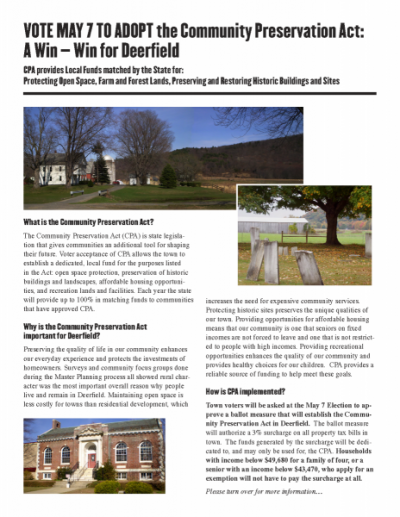CPA Campaign Case Study: Deerfield (2007)
Background
 In the fall of 2006, the Deerfield Board of Selectmen responded to concerns voiced by community members over the increasing loss of open space, particularly prime agricultural land, by appointing a study committee to identify potential resources for open space conservation. Working with The Trust for Public Land's Connecticut River Valley Project coordinator, Clem Clay, the committee began to outline ways in which the community could better manage its growth. Clem suggested that Deerfield consider adoption of the CPA as one way to fund open space protection, and the committee invited staff from the Community Preservation Coalition to give a presentation about CPA.
In the fall of 2006, the Deerfield Board of Selectmen responded to concerns voiced by community members over the increasing loss of open space, particularly prime agricultural land, by appointing a study committee to identify potential resources for open space conservation. Working with The Trust for Public Land's Connecticut River Valley Project coordinator, Clem Clay, the committee began to outline ways in which the community could better manage its growth. Clem suggested that Deerfield consider adoption of the CPA as one way to fund open space protection, and the committee invited staff from the Community Preservation Coalition to give a presentation about CPA.
According to campaign leaders, the presentation generated excitement from study committee members, who then turned their attention to pursuing adoption of the CPA in Deerfield.
The Campaign
At the study committee’s recommendation, CPA was placed on the warrant for a Special Town Meeting to be held in March of 2007. A second open space measure was also placed on the warrant for consideration by the Town Meeting members at the same time.
The Town Meeting vote was successful, and CPA advanced to the ballot. Soon afterwards, a local CPA campaign committee was formed and the campaign for CPA passage was underway! Time was short, however, and the campaign was faced with the daunting task of educating voters on the complex CPA law and the benefits it could bring the community in the space of two short months.
Initially, things went well. Guest columns in the local newspaper provided support and publicity for campaign events, and helped spread the word about the coming election.
However, while the Board of Selectmen agreed to form the initial CPA study committee and hold the Special Town Meeting, not all of the Selectmen came through with strong and open support for the campaign. Some were concerned about the political implications of supporting the CPA.
The campaign pressed on, and while the CPA study committee had focused primarily on CPA as a funding source for open space preservation, the CPA campaign committee presented balanced information about all three (four, including recreation) funding areas of the CPA. Two Selectmen supported this effort by reaching out to town groups with interests in historic preservation and affordable housing. Meanwhile, the campaign committee organized one targeted mailing to all potential “yes” voters.
During the course of this relatively short CPA campaign, campaign supporters did face a mild level of organized opposition from individuals in the community against CPA adoption. Several guest columns in the local newspaper provided an opposing point of view and one anonymous anti-CPA flier was distributed on doorsteps.
Finally, however, on May 7, 2007, the committee’s efforts were rewarded with 52% of Deerfield’s voters casting their votes in favor of CPA. Ultimately, some of the campaign committee members were appointed as founding members of Deerfield’s Community Preservation Committee, and were able to be involved in getting Deerfield’s CPA program up and running.
Lessons Learned and Advice for Future Campaigns
As campaign leaders explain, the Deerfield campaign worked well because a context had already been created for the CPA by the initial CPA study committee. Establishing the CPA study committee allowed the Selectmen to be involved in the process from the beginning. The Selectmen's involvement legitimized the committee, and ultimately, CPA and the campaign for its adoption.

